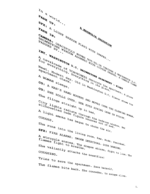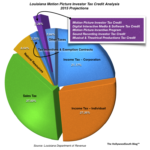How To Post Your Screenplay on Facebook for Valuable Constructive Criticism
 In the Facebook universe there are numerous screenwriting groups, which seem to replicate on a weekly and daily basis. Screenwriters who want feedback from their fellow members sometimes post screenplay pages for others to critique. Posting those pages where they are properly displayed using the available Facebook posting tools receives the best feedback and can be a little tricky without a good digital workflow.
In the Facebook universe there are numerous screenwriting groups, which seem to replicate on a weekly and daily basis. Screenwriters who want feedback from their fellow members sometimes post screenplay pages for others to critique. Posting those pages where they are properly displayed using the available Facebook posting tools receives the best feedback and can be a little tricky without a good digital workflow.
An interesting attribute about social media especially Facebook, is the ability to communicate with people on the Big Blue Marble who in all likelihood will never meet each other in real life. Or, as the fancy kids say “IRL.” This attribute is but one of the values virtual groups can provide those who do not live in Hollywood, or who do not have fellow screenwriters in their neighborhoods, an ability to grow as a screenwriter.
For some, having a collective group of fellow screenwriters give feedback on screenplay pages is an essential element, or sometimes the only avenue, of developing a good screenwriting routine. Unfortunately, posting screenplay pages on Facebook opens the original poster (OP) up to non-constructive criticism, too. This article is devoted to those who want to aim for constructive criticism on their posts.
“Constructive criticism in social media groups is some of the best feedback a new screenwriter can receive.
Ignore the non-constructive criticism. Stop reading it.”
All too often, screenwriters will screenshot their screenplay pages and post them as pictures on Facebook, as there is no option (as of this date) to upload documents. Most of the time, these screenshots are poorly cropped, have mobile icons on the top of the screenshot, or even other apps visible in the screenshot, which is visually distracting. There is just no way to properly critique the formatting for posts like these.
As Facebook really only gives their universe inhabitants the ability to post images, a screenwriter might ask themselves, “How can I post a few screenplay pages as images, properly formatted, to receive the constructive criticisim?”
Regardless of the screenwriting app a screenwriter uses, printing to a portable document format (PDF) is the first step needed to get to a good Facebook post.
Print To PDF First
Using your screenwriting app, print to PDF first. This way you will print a digital document 8-1/2″ by 11″ (English) or, 8.27″ by 11.69″ (A4), which will retain all the margins and spacing needed to properly receive feedback on your pages.
Taking screenshots and cropping them to appear to be properly-formatted pages is bad practice. You will rarely, if ever, get proper feedback.
In Facebook writing groups, I have found about one-third of all the replies received when taking poorly-formatted screenshots will be in the vain of formatting comments. Do not set yourself up for those replies as they have no relevance and flood your post thread. You will not receive any constructive criticism worthwhile on screenshots.
Convert PDF To An Image
Depending on the software programs you use, generally you can convert and/or export your PDF screenplay to a few different image formats. However, Facebook has restrictions on the type of file formats you can upload.

Convert your screenplay pages to either PNG or JPEG file formats at 300 dpi (pixels/inch) for best results. Some programs will default to 72 dpi on export, which will give you blurry text in your images. Be sure to check your settings in your printing/export dialogue box when you begin the process.
My preferred way of converting a PDF to an image is by way of Portable Network Graphics (PNG). Conversely, you can convert a PDF to a JPEG (Joint Photographic Experts Group) image (e.g. <.jp> <.jpeg> etc.). The JPEG image format generally makes for smaller file sizes, however, I prefer the PNG format because Facebook extremely compresses the images spacially (size-wise) sometimes making for a really blurry image.
PRO TIP: Facebook Testing
Try both file formats and observe your results by posting a Facebook post on your profile, setting the audience to Me Only.
Remember, you will have ten individual images (PNGs/JPEGs) for your post, therefore, having the page numbers at the lower righthand corner of the image/page is important.

You can try PNG, JPEG, etc. and post a page (image) to a dummy post on Facebook where only you can see the post. Just post one page for testing and look at the sharpness of the text. Click on the image and zoom in. 300 dpi is great for text images uploaded to Facebook.

Once you find the settings you like, just delete the post.
Be sure to switch your audience back to Public, or whatever setting you had before, or you will end up posting to your Facebook for weeks, forgetting you posted to You (Me) Only.
The Post
When posting a few pages for feedback in your Facebook screenwriting group, only post a few lines about what you want feedback on. Besides, you are probably a member of several screenwriting groups and you will end up posting across all of those. Right? You know you would. You would hate to have your posts look, let’s say, spammy.
The Facebook Post is not where you want to write a whole 5,000+ word disertation on your theories of writing. Those posts generally just get glossed-over when not specifically related to your few pages (images).
Here are some examples, which might entice a group member to read your few pages…
“I am about a third of the way through my screenplay and would like to get some general feedback on the first ten pages.”
“I would like to get feedback on the first ten pages of my Rom-Com.”
“I would like to get feedback on my Sluglines’ formatting.”
You get the idea.
My Screenwriting Setup

For several decades, from floppy disks to the modern download version, I have used Final Draft (FD) to compose my screenplays. I print to PDF using the FD Print feature, select Save as PDF and save the file to my Desktop.
Next, I open Preview and open the FD file/print I just saved. Or, double-click the file and Preview will open.
Export to PNG by selecting File > Export… > Select Format: PNG and set Resolution: 300 pixels/inch.
If you live in the Microsoft Windows world, the steps really are not that much different, other than the tools you use to open PDFs.
I could write a whole book examining all the different writing apps out there and how to get to images for your posts, therefore, experimentation is the best route for your screenwriting setup.
Final Thoughts
Only post a few pages in Facebook screenwriting groups for feedback. No more than about ten pages. If you want to post your whole screenplay, post a link from a publicly accessible host. For example, Google Drive, Dropbox, or even your own website.
Otherwise, you will have so many images in your post, it will become distracting and you will probably get minimal returns on criticism.
Remember, you are looking for feedback on a few pages.
If you want a full screenplay read, host the screenplay for download, or you can have other screenwriting group members contact you.
If you post your email address inside the group, you might open yourself up to a whole lot of email spam. If you tell people to DM you (direct message), you might get so many DMs, they will probably end up in the Other folder in Facebook Messenger and you might never see them. Essentially, losing credibility when chatting with others in the groups.
Remember, some of these Facebook screenwriting groups have thousands and thousands of members, whether or not they are active participants in the groups.
Post no more than ten pages for a quick review in a Facebook post, or post a publicly-accessible link for entire screenplays. That’s it!
Your mileage may vary.
Good luck!
– Stan




